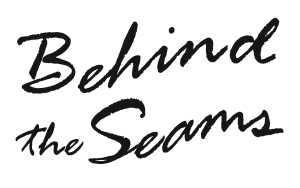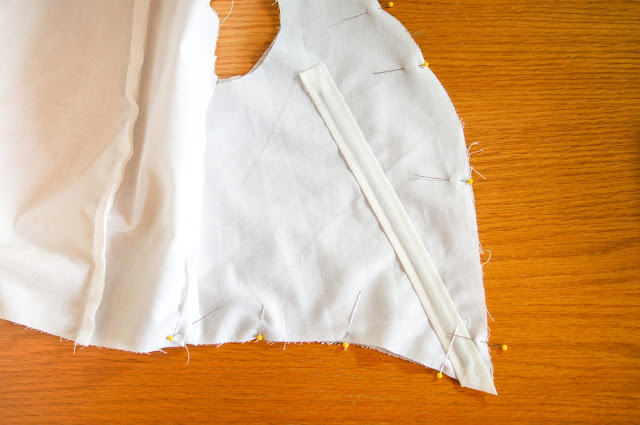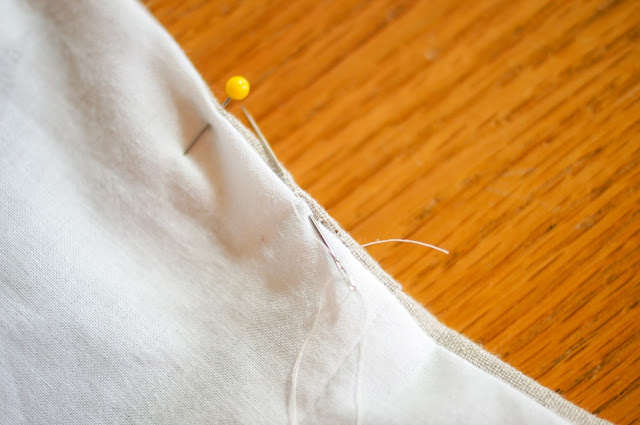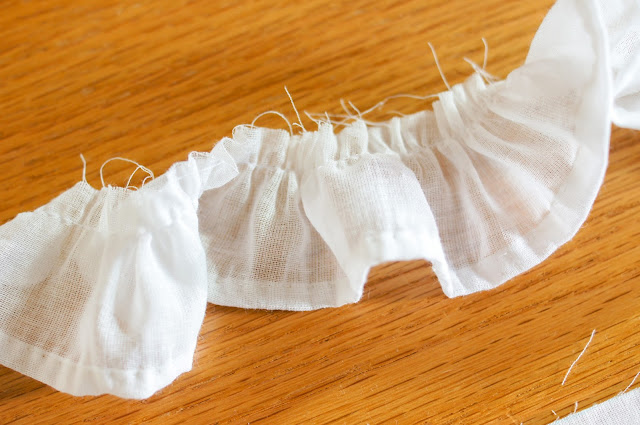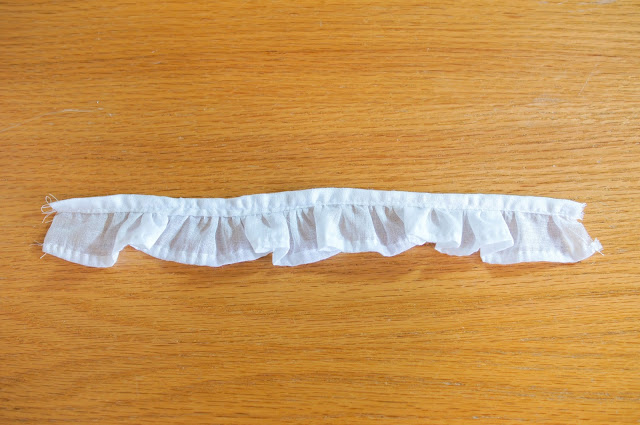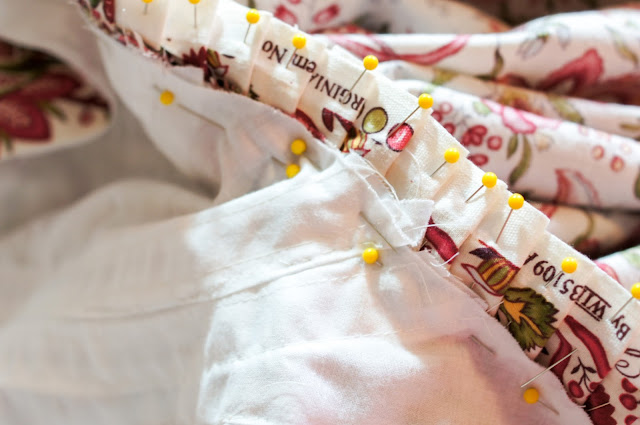Continuing my posts on the making of my
1770's Robe a la Polonaise, today I'll be showing how I made the sleeves the skirt. If you haven't read my
first post about making the bodice, you can read it here.
After my bodice was constructed it was time to get started on the sleeves! When editing my photos I realized I didn't take as many photos of the sleeves as I should have, so I'll attempt to explain anything I don't have photo's of. Hopefully it will all make sense.
Like the rest of my bodice pieces, I cut the sleeves out of both my fashion fabric and muslin for the lining.
Once the pattern pieces were cut I made sure to mark the sleeve dart (below) onto the right side of my muslin pieces.
Once the pieces were cut, I stitched each of the sleeves individually, right sides together. Then, taking two matching sleeve pieces (lining and fashion fabric), I placed the lining inside of the fashion fabric piece with right sides together and stitched around the edge/cuff. Once it was stitched I clipped the curves and turned it right side out then turned the lining into the sleeve so that wrong sides were together on the inside.
At this point I top stitched around the edge of the sleeve. After that, I pinned down the dart, following the makings on the inside of the sleeve from my pattern. I top stitched along the top, stitching the dart into place.
Next I began working on the sleeve ruffles. Janet Arnold's pattern had large, frilly, ruffled cuffs with a scalloped edge with two layers for each sleeve. Below is the pattern I had drafted based on the one from Patterns of Fashion.
The fabric I used was a cotton voile I purchased in L.A. last year at
Costume College. It's very light weight and has a wonderful drape and I knew I had to use it for this.
Once the pieces were cut, I began trying to hem the edges. Due to the round/scalloped edge it made hemming difficult and I quickly realized it would be more trouble than it was worth to trying and hem all four pieces and I decided on an alternate plan; a straight edged, plain ruffle. Easy and simple.
I started by cutting the ruffle pieces I had already cut down to straight strips. I cut two on the fold, an approximate length of 26" long by approx. 2.5" wide.
I hemmed the bottom edge with a 1/4", folded over twice and stitched down by hand. Then along the top I machine stitched a gathering/baste stitch.
I also cut another two strips for the cuff of the ruffle. With right sides together, I stitched the cuff to the ruffle, then folded the cuff in half, covering all raw edges, and machine stitched it down.
Then with right sides together, I stitched the ruffle together.
After that, I hand stitched the ruffle cuff's into my sleeve's.
The skirt is made up of 2 rectangular panels, approximately 2 yards by 42" long each. My original plan was for each panel to only be about 1 1/2 yards long, but when I got my fabric and realized I didn't have enough for trims anyways, I used all that wasn't being used for the bodice and sleeves to make it extra full. This is probably a little more fabric that is needed, but I like how full it is.
With my two panels cut, I measured 3" down from where the center back seams would be and marked with pencil at an angle until it was even with the original edge of the fabric, creating a downgrade (hopefully this makes sense). This is because the center back of my dress dips down, and to keep the skirt even and to make it lay right, it needs to be that much shorter in the back and sloping on the sides.
Once that was done, I stitched the center back seam with right sides together, finishing at my 3" mark. After that, I hemmed the front edges of the skirt, folding the edge over 1/2" and over another 1/2" and machine stitched it. If I were to do this again I would definitely sew this part by hand because the stitching is more obvious than I thought it was going to be on the finished dress.
Now it was time to pleat the skirt. I attempted to measure everything out with math to calculate exactly how many please and what size they needed to be, but I wasn't able to figure it out and my head began to hurt from all the numbers (math and I aren't very good friends). Instead I did the pleats by eye, measuring approximately how long the bodice edge was and adjusting as needed. The hardest part of doing it this way is making it even on both sides. But after a couple of hours I got all tidy and even.
For some reason at this point I didn't base my pleats down and instead stitched them right into the dress. I usually (and would recommend) basting your pleats once you have them pinned the way you want before attaching it to the bodice. This is also a good time to iron them, before you stitch it to the dress, that way you can get them all nice and flat easily.
I stitched the skirt to the bodice by machine, using a 1/2" seam allowance from the edge of the bodice.
At the bottom of the center back of the bodice, I had to hand sew the tip. I chose to hand sew this section because I didn't want to risk getting any of the pleats in the wrong position with my machine, and you have so much more control when sewing by hand.
At this point I also attached the skirt loops, which in my case was a few feet of brown ribbon. I stitched them onto the seam allowance of the inside of the bodice. These are to hold the skirt up in the back by looping around buttons on the outside.
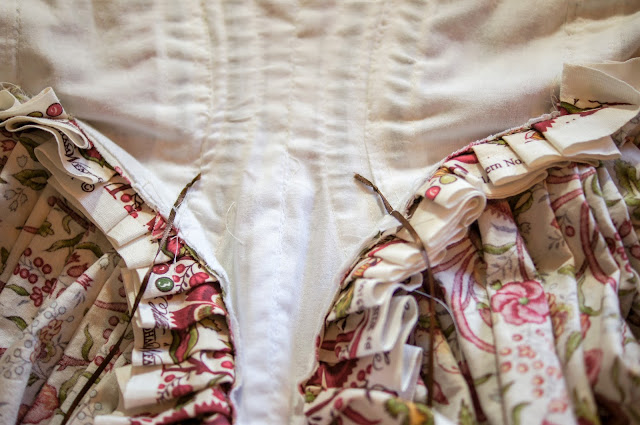
Next was time to finish up the bodice, starting with the rest of the bottom edge. I did a small rolled hem, trying to keep it as close to a 1/4" fold as I could and then stitched it down by hand going just past where the skirt starts.
I did the same thing with the bottom edge and then the center front edge, though with a slightly larger seam allowance at 1/2" folds.
After that, all that was left was to sew on a couple of buttons and hem the skirt (which unfortunately I didn't get any photo's of, though it's pretty simple), which I did by hand with an invisible stitch.
After I figure out what to accessories this with (mainly figure out what to do with my hair) I'm hoping to get photo's of me actually wearing this soon.
